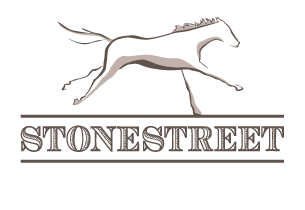October is a busy month at the Stonestreet Training Center in Florida. Yearlings have arrived from the major yearling sales and breeding farms all over the United States. After a week to settle in and adjust to the new routine it’s time for them to be “backed”, the term describing the process of teaching babies how to be ridden.
Thoroughbreds are extremely well handled from birth and this makes the transition quick and easy in most cases. The key, as with everything equine, is tweaking the process to suit the individual and letting the horse dictate the pace.
Surcingle
1. The yearling is introduced to the tack consisting of bridle, saddle pad and surcingle in the stall. Most yearlings will have already experienced a bit in their mouth, especially if they went to the Yearling Sales. One handler will hold the yearling while another places the saddle pad on the back and tightens the surcingle. A surcingle is an elasticated strap that fastens around the girth area. Once the tack is secured, the key is to keep the yearling moving in circles around the stall in both directions – horses are much less likely to get themselves in trouble or become upset when in forward motion and this principle is applied throughout the backing process!
2. Once the yearling is comfortable circling the stall with the surcingle and pad the saddle itself is introduced. They will circle the stall in both directions until they are used to the increased weight and coverage of the saddle and the movement of the stirrups against their flank.
A rider lays on the back of a yearling in the stall
3 .The yearlings will leave the confinement of the stall and walk the shed row while wearing the saddle and bridle.
4. It’s back to the stall for riders up for the first time. With a handler at the head, and continually circling the stall,a second handler will leg the rider up so that he or she is lying on his chest across the horses back. If the yearling is upset by this new sensation the rider can quickly and safely jump away. Once the yearling is accepting of the prone weight of the rider they are legged up into the typical seated position in the saddle, but keep their feet out of the stirrups.
5. With both rider and horse comfortable and calm they exit the stall and jog around the shed row without the handler. All the circling in the stall has taught them a basic understanding of the bit as a component of steering.
6. After a week jogging in the shed row the yearlings are ready to move to the small field. Graduating from Step 1 to Step 6 typically takes about 10 days however, some horses will need a couple of days off to absorb all the new information and will start back at Step 1.
7. Once in the small field they jog figure of eights for one week. The turns of the figure eights refines their steering and keeps their minds busy.
8. The group transitions to a larger field where they canter figure of eights for seven days.
Yearlings jog in figure eights
9. The yearlings are ready to head to the racetrack itself and the entire process has taken 5 weeks. They will get used to the racetrack and its rules.
Many of the yearlings will be backed and then turned out for a several weeks, sometimes longer for a late maturing individual. The following year they will pick back up these early lessons quickly and get on with the job of being a racehorse.
All racehorses are taught to turn toward the center of the track and stand calmly. This signifies the end of training for the day. Never heading to the barn at speed prevents bolting for home mid-work.
